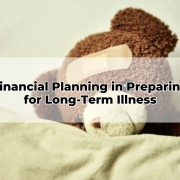Financial Planning for Australians Going Through Financial Hardship
Table of Contents
ToggleFinancial hardship is not a foreign concept to many Australians. Whether due to job loss, illness, relationship breakdown, natural disasters, or unforeseen expenses, hardship can strike without notice. For individuals and families alike, navigating these rough waters requires not just emotional resilience, but calculated, professional financial planning. As a seasoned Toowoomba Financial Adviser, I’ve observed that most people delay seeking help, which often exacerbates their financial condition. Recognising the signs early, and taking deliberate steps, can significantly mitigate long-term financial impact. The role of a financial planner becomes critical in such circumstances-not only to assess the current state but to design a strategic path forward.
Recognising the Signs of Financial Stress
The early warning signs of financial distress are often subtle but persistent. Missed bill payments, frequent reliance on credit cards for necessities, escalating personal loans, and increasing anxiety about money are clear indicators. Many Australians normalise these symptoms until they snowball into more serious issues like debt recovery actions or mortgage defaults. Identifying financial stress is the first step in reclaiming control. Financial planning in Toowoomba includes evaluating such red flags with precision, providing individuals the clarity they need to make proactive decisions. Ignoring the signs can compromise not only one’s financial future but also mental and emotional wellbeing.
Assessing Your Financial Position Objectively
During financial hardship, objective financial analysis becomes paramount. This process involves listing all income sources, debts, liabilities, ongoing expenses, and available assets. While this might feel confronting, it offers a factual base to build a recovery plan. An Online Financial Adviser can assist Australians no matter their location, using secure digital platforms to conduct comprehensive financial assessments. Accurate knowledge of your net position allows for realistic goal setting and prioritisation of cash flow. This clarity is essential to move from a reactive financial state to a proactive one, empowering you to make calculated and beneficial changes.
Rebuilding Your Budget for Financial Survival
A robust budget is the cornerstone of any financial recovery strategy. However, a hardship budget requires a more austere and prioritised approach. It focuses on essentials-housing, food, utilities, and healthcare-while cutting non-essential expenses entirely. Discretionary spending must be eliminated or sharply reduced. Budgeting tools and financial planning software help streamline this process, but professional guidance ensures the budget is realistic and sustainable. As a Toowoomba Financial Adviser, I often see that clients benefit from having a structured framework that not only guides spending decisions but also helps manage stress and expectations during difficult times.
Accessing Government and Community Support Services
Australia offers a range of support systems for individuals undergoing financial hardship. These include Centrelink payments, early access to superannuation in extreme cases, rent assistance, and utility hardship programs. Additionally, local community organisations often provide food relief, emergency accommodation, and financial counselling. Many Australians are unaware of the extent of these services or how to access them. A financial adviser bridges this gap by connecting clients to appropriate resources and ensuring applications are completed correctly and on time. This support can provide temporary relief and form part of a broader long-term financial recovery plan.
Managing Debt During Hardship
Debt management becomes a high priority in periods of hardship. Rather than ignoring debts, proactive engagement with creditors is essential. Many lenders offer hardship provisions, such as reduced repayments, payment pauses, or interest-only periods. Consolidating debts into a single manageable repayment or restructuring obligations can reduce stress and improve cash flow. An experienced financial adviser provides critical support in negotiating these terms. In some instances, informal debt agreements or temporary hardship variations may be more beneficial than formal insolvency procedures. Each situation is unique, and professional advice can distinguish the most strategic course of action.
Prioritising Superannuation and Retirement Goals
In times of financial pressure, retirement planning may fall by the wayside. However, even during hardship, it’s vital to maintain a long-term perspective. Superannuation remains a cornerstone of future financial security. While early access to super is possible under strict hardship provisions, this should be considered a last resort due to the compounding impact on retirement savings. As a Retirement Financial Advice specialist, I assist clients in balancing current needs with future retirement goals, helping preserve as much superannuation integrity as possible. Long-term security should not be sacrificed without careful evaluation and expert oversight.
Reviewing and Adjusting Insurance Cover
Insurance plays a pivotal role in financial resilience, yet during hardship it is often the first expense cut. This can be a critical error. Life, income protection, and total permanent disability cover provide essential safety nets. Rather than cancelling outright, policies can often be adjusted or suspended temporarily to reduce costs without forfeiting coverage entirely. Insurance premiums can also be paid from superannuation to ease cash flow pressure. A professional adviser evaluates these options and guides clients through any restructuring, ensuring essential protection remains intact while aligning with current financial capacity.
Avoiding Common Pitfalls During Financial Hardship
In desperation, individuals often turn to quick-fix solutions such as payday lenders, buy-now-pay-later schemes, or early super withdrawals. While these may offer immediate relief, they often lead to longer-term financial deterioration. Another frequent pitfall is relying on emotional decision-making rather than data-driven strategies. Acting on fear can lock in losses, destroy credit ratings, and erode assets. Effective financial planning ensures all decisions are considered and supported by strategy, not emotion. Avoiding these pitfalls can make the difference between a temporary setback and a prolonged financial decline.
Crafting a Recovery Roadmap
A recovery plan provides structure and direction. It transforms the situation from overwhelming to manageable. This plan should include financial goals, timelines, debt repayment strategies, income enhancement options, and budget milestones. Regular reviews are essential to assess progress and make necessary adjustments. Leveraging the guidance of a Toowoomba Financial Adviser ensures this roadmap is not only realistic but also tailored to your unique circumstances. Recovery is rarely linear-it involves setbacks and course corrections-but having a roadmap provides confidence and keeps you moving in the right direction.
Leveraging Digital Financial Advice Platforms
Technology has revolutionised the accessibility of financial advice. Australians can now consult an Online Financial Adviser regardless of geographical location, removing barriers to support. Secure portals, virtual meetings, budgeting tools, and automated reminders enhance engagement and accountability. This is especially valuable during hardship, where mobility or transport access may be limited. Additionally, digital platforms often offer more cost-effective solutions, making advice more accessible during lean times. Financial Planning Toowoomba includes a blend of traditional consultation and online services to accommodate diverse client needs and preferences.
Planning for Income Recovery and Growth
Long-term financial recovery isn’t just about cutting costs-it’s also about boosting income. This might involve upskilling, switching careers, or generating passive income through investment or business opportunities. Government grants, training incentives, and job search platforms offer starting points. Financial advisers help evaluate the cost-benefit of each option and ensure any investment of time or money aligns with long-term goals. Increasing income not only accelerates debt repayment but also rebuilds confidence and stability. It’s a critical component of a full-spectrum financial planning approach.
Rebuilding Financial Confidence and Mental Wellbeing
Financial hardship often takes a toll on mental health, leading to anxiety, shame, or paralysis in decision-making. Rebuilding confidence involves more than financial literacy-it includes mindset coaching, stress management, and celebrating small wins. A trusted adviser provides not just technical guidance but emotional reassurance, creating a sense of partnership through the recovery journey. Clients are reminded that setbacks are not failures but opportunities for course correction. Restoring financial confidence is the final step in emerging stronger, more resilient, and better equipped to handle life’s financial challenges ahead.
Conclusion
Financial hardship may feel isolating, but it is a challenge that thousands of Australians navigate every year. With the right strategies, professional guidance, and ongoing support, it is entirely possible to regain financial control and rebuild with confidence. Whether you’re seeking immediate relief or long-term stability, Wealth Factory offers tailored solutions through both face-to-face and online financial advice. As a Toowoomba Financial Adviser and Retirement Financial Advice specialist, I encourage anyone experiencing financial stress to reach out early. The sooner a plan is in place, the sooner stability returns.









